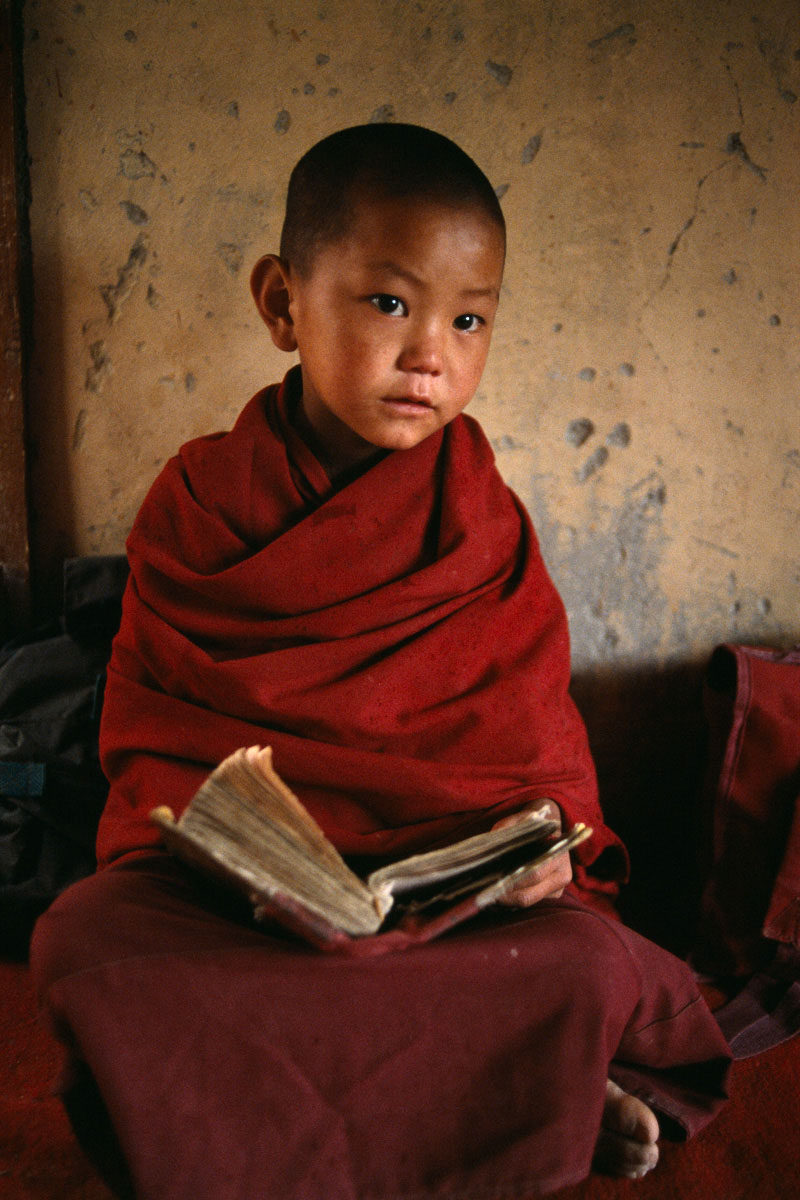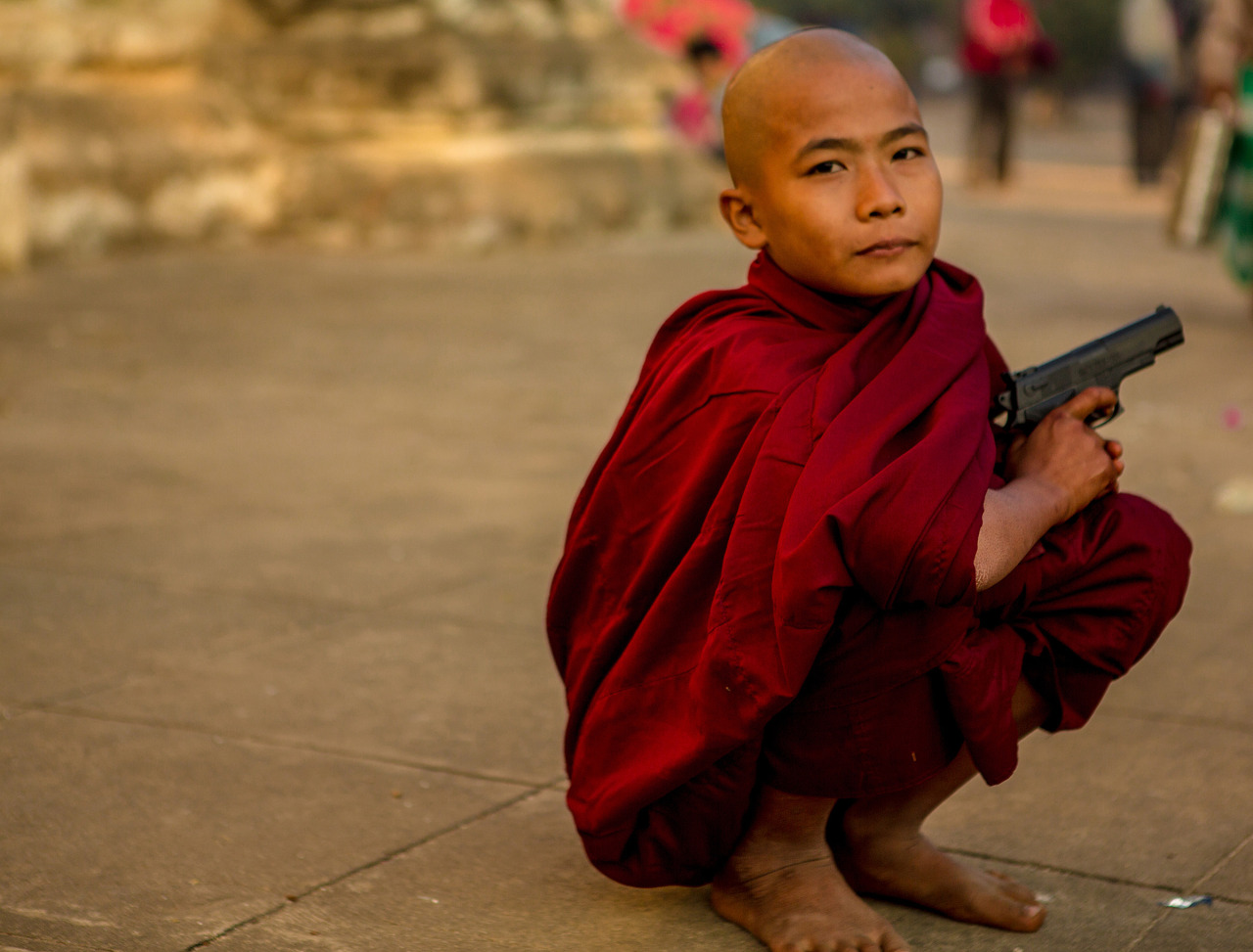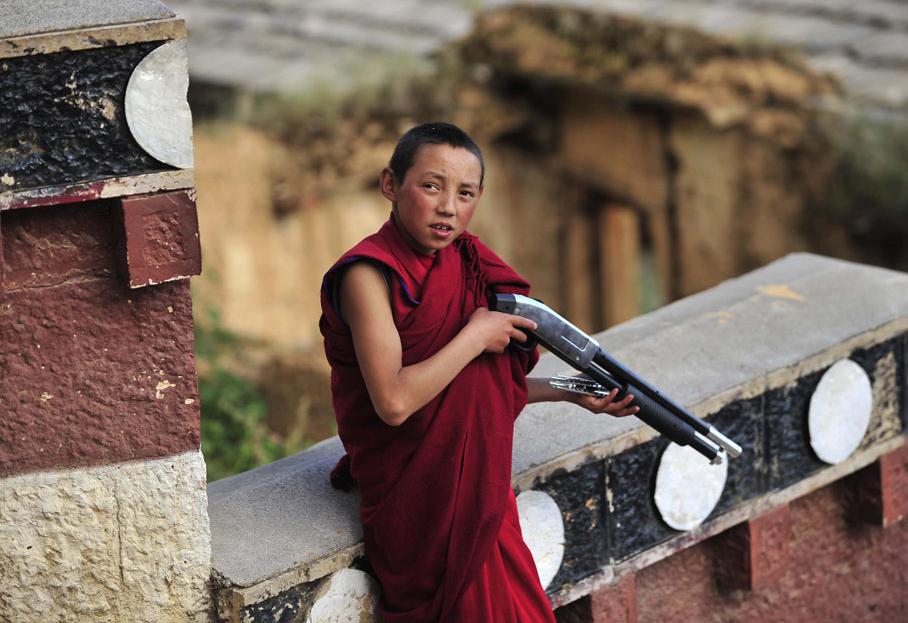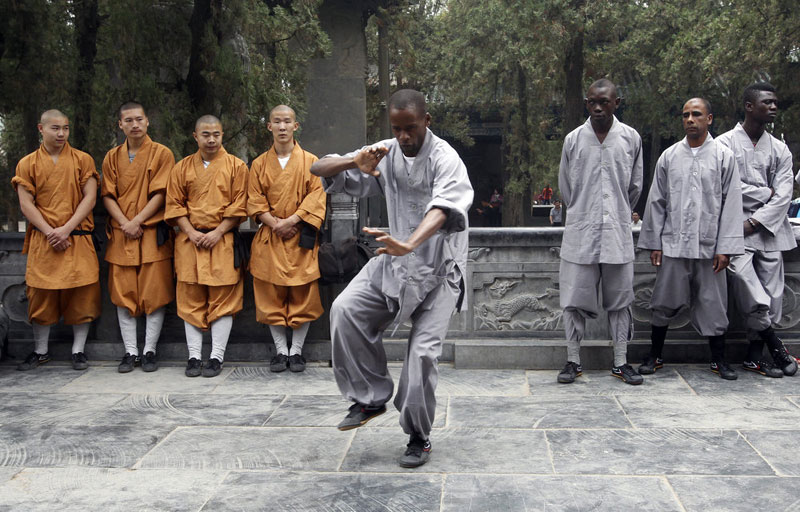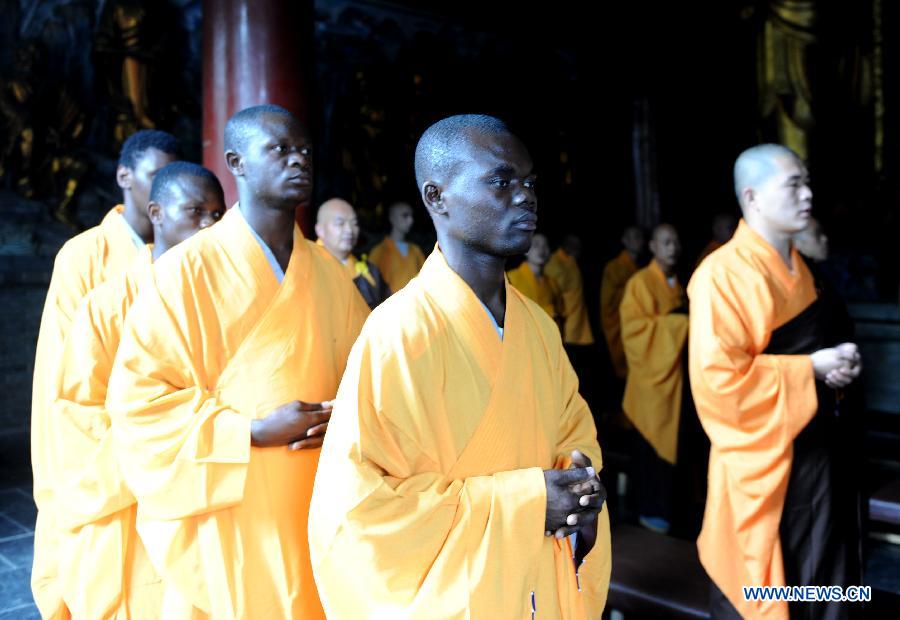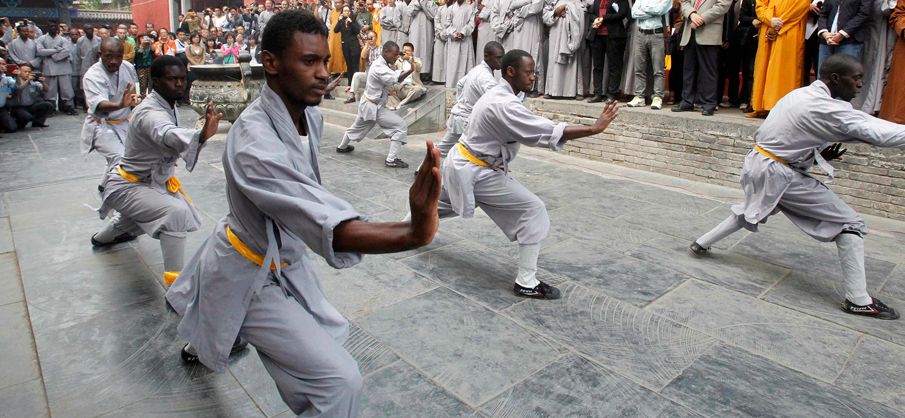It has happened twice today that I came across the phrase, "militant Buddhist." I'm a bit surprised.
What are your thoughts? Is that one of the paths people generally don't talk about?
If I may say,
There are teachings within Buddhism that advocate for non-violence. Nonetheless, many other teachings within the camp also made room for violence to occur as well. I am reminded of
the Nirvana Sutrana Sutra, a canonical Buddhist text, which narrates a story about one of Buddha’s past lives: in it, he kills some Hindus (Brahmins) because they insulted the Buddhist
sutras (scriptures):
The Buddha…said…”When I recall the past, I remember that I was the king of a great state…My name was Senyo, and I loved and venerated the Mahayana sutras…When I heard the Brahmins slandering the vaipulya sutras, I put them to death on the spot. Good men, as a result of that action, I never thereafter fell into hell. O good man! When we accept and defend the Mahayana sutras, we possess innumerable virtues.”
The very first reason we're told the Buddha put the Brahmins to death was out of pity for them in order to aid the Brahmans in avoiding the punishment they had accrued by committing evil deeds while continuously slandering Buddhism. And that is a theme found throughout Buddhist thought when it comes to “compassionate killing” since killing is normally forbidden because it is done with evil intent (hatred, vengeance, etc.), yet the times when it is done with “compassion” makes it permissible and worth celebrating..
One excellent perspective I came across put things into perspective when it came to noting the ways that experiences in status can cause a shift in one's leanings. For more information, as seen in
Why Are Buddhist Monks Promoting Violence in Sri Lanka - Political Violence @ a Glance.
:
Religious Affairs, K. D. S. Gunawardena, gave a speech in which he proudly declared an end to decades of communal violence. While Gunawardena was speaking in Colombo, a group of Buddhist monks were parading the streets of Kuliyapitiya in northwestern Sri Lanka calling for the deportation of all Muslims. Commentators once optimistic about the future of post-civil war Sri Lanka nowask if Muslim identity is a liability in the island state.
To outsider observers, the Buddhist majority’s sudden targeting of religious minorities may come as quite a shock. For the bulk of its post-independence history, Sri Lanka has been dominated by the conflict between the Sinhalese and the Tamils. Though the Sinhalese (74% of the population) are mostly Buddhist and the Tamils (12%) are generally Hindu, the decades long civil war ending in 2009 was largely secular in nature. Conflict began over the question of Sri Lanka’s official language and escalated to issues of territorial control. It was a conflict between religions but it was rarely a conflict about religion.
Since the mid 2000s, however, Sri Lanka has seen hundreds of violent incidents between Buddhists and Christians or Muslims. Generally, one out of three such incidents involves Buddhist monks in some capacity. Moreover, the US State Department cites several incidents in which victims have been threatened for reporting religious violence to the police, suggesting that many more incidents may go unreported.
To find the underlying causes of this violence, one need only look at the changing position of the Buddhist clergy in Sri Lankan society. Over the last several decades, Sri Lanka’s traditional Buddhist leadership, composed of nearly 30,000 monks and known collectively as the sangha, has become more fractured and more political. For centuries, the sangha has been divided into a number of sects and regulated by a high council. The high council was traditionally responsible for dispensing material support from the state and regulating the behavior of the monks in each sect. This hierarchy ensured a degree of doctrinal consistency across the sects by granting senior monks the authority to discipline their subordinates.
This system changed dramatically in the mid-20th century, when the Sri Lankan state withdrew its material support to the sangha. The loss of support made the sangha dependent on lay worshippers while also undermining the power of the high council. Without enforcement from above, the religious hierarchy came to lack authority. As a result, individual monks were granted the autonomy to deviate from their community.
The economist Laurence Iannaccone of Santa Clara University has argued that more radical religious organizations tend to extract the most resources from their adherents. Doctrinally strict religions tend to reduce the number of “on-the-fence” adherents while encouraging ardent believers to become as involved as they can.
In Sri Lanka, the dismantling of the Buddhist hierarchy coupled with a shortage of material resources encouraged many monks to embrace radicalism. Variation in this behavior can even been seen at the local level. Monks from historically wealthy temples tend to support a more traditional interpretation of Buddhism, while monks from historically poor temples tend to embrace a more radical message.
The effect of this resource competition has been a general increase in both the radicalism and political activism advocated by monks. Especially since the 1970s, a growing number of monks have endorsed radical ethnic politics as a means of self-promotion. It was during this period that a series of influential monks began to preach against religious minorities.
Additionally, as mentioned
elsewhere on the extent of Buddhist violence (for a brief excerpt):
What’s truly disturbing to many is that groups like the 969 Movement in Myanmar and Bodu Bala Sena in Sri Lanka aren’t just composed of Buddhists, but are led by monks as Buddhist groups, purportedly operating on Buddhist beliefs and under Buddhist doctrine, to promote violence and aggression. Yet while this explicitly Buddhist violence feels incongruent with the faith, there’s actually a long, but often forgotten historical tradition and strong theological basis for violence in (and in the name of) Buddhism.
Although TIME magazine’s coverage of the Southeast Asian surge in Buddhist violence has snapped attention towards the issue, the coverage has colored the history of much of recent history. A Buddhist monk led a major assassination plot, known as the League of Blood Incident in 1932 Japan. In the 1970s Laotian and Thai Buddhists took up arms against communists, declaring that it was not karmically wrong to do so. From 1983 to 2009, Buddhist monks sanctioned aggression against the Liberation Tigers of Tamil Eelam in the Sri Lankan Civil War. Since 1992, one of the major militias fighting the Myanmar government, the Democratic Karen Buddhist Army, has been led or under the influence of a monk named U Thuzana. In 1995, the Japanese cultic terrorist group Aum Shinrikyojustified their release of Sarin gas on the Japanese subway system by claiming that they were liberating less enlightened beings in accordance with tantric Buddhist teachings. And as recently as 2004 and 2008, respectively, Thai monasteriesbecame militant bases in the conflict between local Muslims and Buddhists and Chinese officials claimed to have found weapons caches in Tibetan temples.
And that’s just the last century. Entire books have been written on the history and theology of Buddhist violence. Many violent Buddhist leaders or sects have drawn upon variations of the Mahaparinirvana and Upayakaushalya Sutras, theKalachakra Tantra and other Buddhist writings in a wide and ever-evolving non-static canon to justify their actions. These scriptures explicitly enjoin believers, under certain conditions, to kill or maim in defense of the Buddhist faith, to spread Buddhist beliefs and values, or to prevent the death of others. Most troublingly for the casual observer, one of the fundamental stories of the past lives of the Buddha tells of a time when he was a ship’s captain who learned of a passenger’s intent to kill 500 people on the boat. The Buddha resolved to kill the killer, and considered it not a sin, but an act of compassion with (depending on interpretations) little to no negative karmic repercussions, as he’d the man from accumulating bad karma and saved everyone else as well.
These beliefs were at play in the foundation of the wushu martial arts, the granddaddy of karate, kung fu, and tarkwondo, amongst the Shaolin Buddhist monks of China as far back as 1,500 years ago; contrary to some stories, their martial arts weren’t entirely defensive as they sent a cadre of monks to help the Chinese Tang dynasty conquer and establish a peaceful realm for Buddhism to thrive and prosper. They also factor into the Tibetan legend of the 841 assassination of King Langdarma, a supporter of the pre-Buddhist Bon religion who dismantled Tibetan state support for monasteries; the Buddhist monk and former warrior Lhalung Pelgyi Dorje determined that he could save both the king and the faith, and thus commit an act of karmic good, by assassinating the king and escaping to resume his monastic practice.
Even modern proponents of the happy, peaceful vision of Buddhism, like the 14thDalai Lama, admit that their nonviolent ideals exist in a violent world, and allow some leeway. The Dalai Lama, whose predecessor actually tried to develop and modernize a centralized Tibetan army, notoriously endorsed the killing of Osama bin Laden and in 2009 described how physical violence could be construed as nonviolence if done with compassion in mind.
Other modern monks differ with the Dalai Lama, the violent Buddhist groups, and the veracity, validity, or relevance of certain ancient scriptures. But no matter how much they protest, the scriptures leave room for Buddhist violence as a holy justification
Moreover, as another wisely noted best on the matter at
Killing in the Name Of | Tricycle:
In the 20th century, Tibetan monks took up arms and fought bravely against the Chinese troops of the People’s Liberation Army. Earlier in the century, they had fought against British invaders; troops of the Younghusband expedition took protective amulets, pierced by bullets, off the bodies of the Tibetan dead.
In Japan, during the Second World War, Buddhist monks, especially those of the Soto Zen sect, supported the aggression of Japanese troops in China and Korea. In previous centuries, many Japanese monasteries had their own armies, called sohei, made up of professional soldiers who wore monks’ robes but were not ordained, changing into their armor when it was time to fight, often against rival Buddhist armies.
Buddhism, like other world religions, has its own justifications for violence. The great chronicle of Sri Lanka, the Mahavamsa, tells the story of King Dutthagamani, who led his troops into battle against the Hindu Tamils who occupied the island. Dutthagamani himself killed the Tamil king in battle using a spear adorned with a relic of the Buddha. He then plunged the spear into the ground and ordered that a stupa be built over it. As a Buddhist, Dutthagamani was troubled by the carnage he had wrought, with tens of thousands of the enemy lying dead on the battlefield. He called in a group of arhats (enlightened monks) to calculate the negative karma he had accrued by so many acts of murder. They explained that he was guilty of killing only one-and-a-half people. Among the enemy dead was one person who had taken refuge in the three jewels of the Buddha, dharma, and sangha and had taken the five precepts of a Buddhist lay disciple (upasaka). He counted as one person. Another of the dead had only taken the refuges but not the precepts, and so counted as half a person. The rest were not people, so the king accrued no negative karma for their deaths.
Buddhism has been supported by all manner of kings and emperors over its long history. One of their motivations for doing so was to protect their lands from invaders. Huguo Fojiao, or “state protection Buddhism”—the idea that by supporting the community of monks and nuns, a kind of religious force field would guard the kingdom from harm—is a central theme of East Asian Buddhism. The first Zen text written in Japan, by the monk Myoan Eisai, was entitled “Promoting Zen in Defense of the State” (Kozen gokokuron). And perhaps the most famous of the Chinese Buddhist apocrypha (texts written in China that purport to be of Indian origin), the Renwang Jing(“Scripture for Humane Kings”), is devoted in part to the theme of state protection.
In some cases, the protection does not work, leading to dreams of revenge. The Kalacakra Tantrapredicts that in the future, a great Buddhist army will sweep down from the Himalayas to defeat the barbarians who had driven the dharma from India long ago. These barbarians are followers of someone called Madhumati, an Indian attempt to render into Sanskrit the name Muhammad.
Violence in Buddhism is not always committed by physical means. In tantric Buddhism, so-called “liberation” rites are performed to liberate (that is, kill) one’s enemies. The great Tibetan translator Ra Lotsawa used such rites to murder the son of Marpa, the teacher of Milarepa. Farther east, when Korea was facing an invasion from Tang China in 670, the Korean thaumaturge Myongnang used powerful spells (mantra) he received from the undersea Dragon King protector of Buddhism to generate a typhoon that would sink the Chinese flotilla. (It worked.) When the Japanese invaded China in what would become the Second World War, the Chinese invited the Panchen Lama to come to China and perform tantric rituals in order to repel the invaders. (It didn’t work.)
To be clear, I am in no way advocating for the idea that Buddhist have no right to defend themselves - or protect themselves if their rights are being violated. This is something that has always been a big deal within Christianity and often caused battles in groups saying Christians couldn't do self-defense or that Christians protecting themselves were automatically equal to those promoting mass violence in the abuse of the Tanak/Scriptures (more shared in
Obama Equates ISIS to Crusades and
here and
here /
here in
Monks/Monastics vs Military Might: Is Self-Defense against Perversion Right? and
but.. are they Christian?).
And of course, there are many peaceful ideals within Buddhism which Christians have echoed in the past (just as Buddhist have echoed them) - as discussed earlier
here and
here. Again, even the ideals of Buddha were taken to mean completely different things than what others say were intended - as we can see in regards to what Buddhists/scholars have said when it comes to Buddhist being exceptionally violent in the name of achieving Buddhahood and having their actions based in Buddhism through Asian history
(as Dr. Stephen Turnbull and others have noted best here or here with the Japanese Warrior Monks AD 949-1603 and many others in history, from Sri Lanka's Violent Buddhists and
Myanmar's Buddhist or Col. Sugimoto Gorō and other instances which Buddhists have pointed out for accuracy...more in
"Buddhist Warfare": Is Buddhism A Religion of Peace?"
).
http://religiondispatches.org/monks-with-guns-discovering-buddhist-violence/



